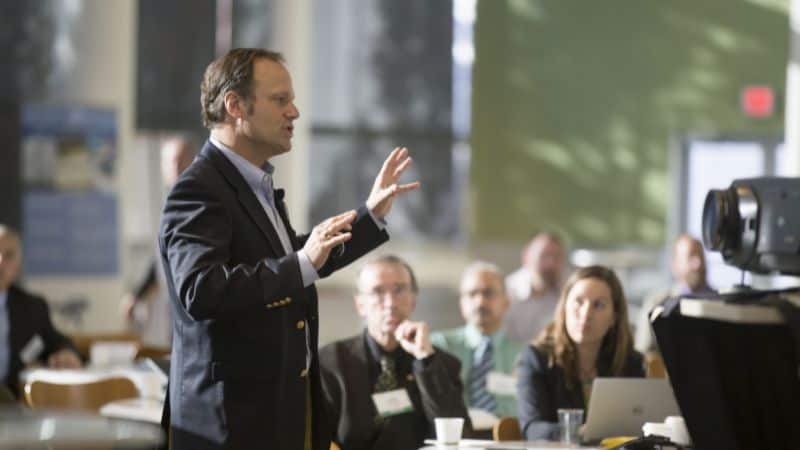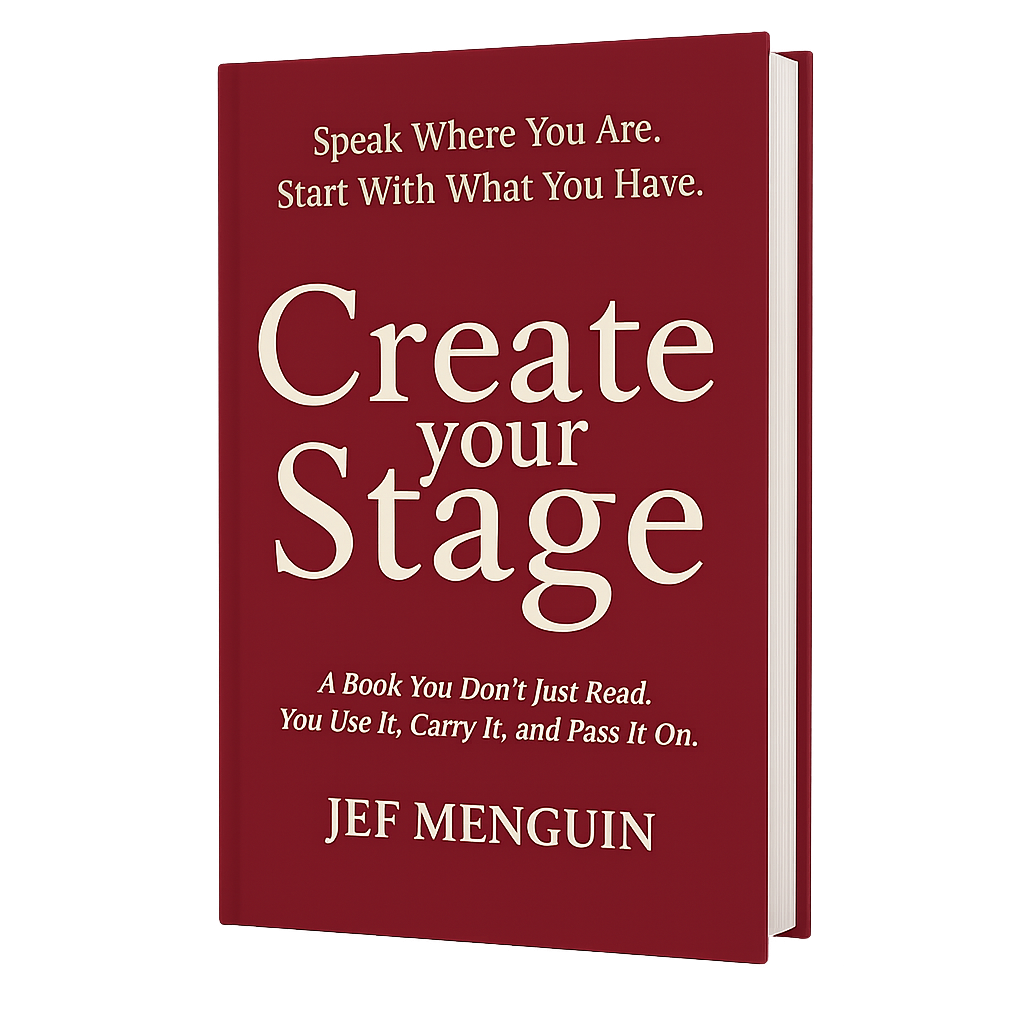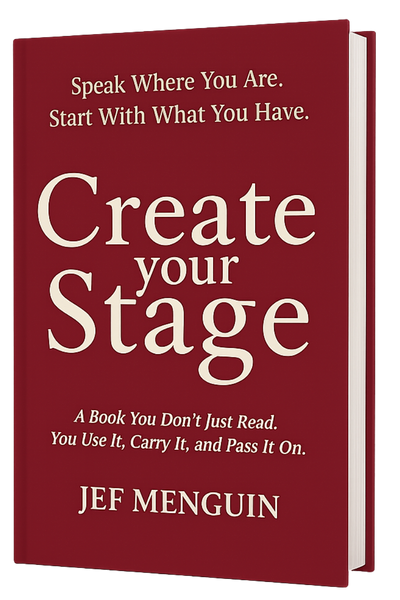Almost every professional speaker you meet will tell you this: “I will customize my talk for your audience.” It sounds good. It sounds respectful. It sounds like you’re getting something special.
Audiences don’t really care if your speech is customized. What they care about is whether your message solves their problem.
I used to sell “tailor-fit” talks, too. It was my promise to every client. But a single conversation with the president of a Philippine bank changed my perspective—and, honestly, my career. That day, I realized something most speakers overlook: people don’t remember whether your talk was customized. They remember whether your talk created clarity, courage, or change.
This article is about that lesson. We’ll explore why some of the world’s most famous speakers—from Russell Conwell with Acres of Diamonds to Og Mandino with The Greatest Salesman—delivered the same speech thousands of times and still packed rooms. And I’ll share why one Filipino bank president insisted that his people hear the same talk, word for word, without a single edit.
Because at the end of the day, professional speaking is not about novelty. It is about solutions.
The Customization Myth (and the Truth Behind It)
When speakers say, “I customize my talks,” what they usually mean is this: they will insert your company name into their slides, mention your industry in the introduction, or add one story about your context. It’s a light edit. Cosmetic. A paint job.
That’s why many “customized” speeches feel generic. The outline is the same. The points are the same. Only the names and the anecdotes change.
But clients believe they want this. They think customization means they’re getting something special—something no other company has ever heard. It reassures them that the talk is worth the fee.
Cosmetic customization doesn’t create transformation. It creates familiarity, but not impact.
I used to sell that promise too. “I will tailor-fit my talk to your needs,” I would say. But the bank president who pulled me aside after a 90-minute keynote taught me a bigger truth. He said, “Don’t change it. Let my people hear the same speech.”
That moment opened my eyes: real customization is not about changing your stories. It’s about choosing the right solution.
When I speak on leadership, teamwork, or culture, I don’t ask, “What new twist can I add for this audience?” I ask, “What problem do they need solved today?” That’s the essence of true customization—matching your tested message to the pressing question in the room.
Because audiences don’t need a “different” speech, they need a relevant solution.
The Case for Signature Speeches
Some of the most successful speakers in history did not rely on endless customization. They relied on mastery.
Take Russell Conwell, for example. His signature talk, Acres of Diamonds, was delivered more than 6,000 times across the United States. The core story never changed. Audiences knew it. Organizers knew it. Yet every time, people filled the room. Why? Because the message solved a timeless problem: people searching far and wide for success without realizing they were standing on opportunity right where they were.
Or consider Og Mandino, author of The Greatest Salesman in the World. He once admitted being surprised that he delivered the same speech three times to the same church. He worried the audience might be tired of hearing it. Instead, they still bought tickets—and thanked him afterward. His message was that powerful, that needed.
A great speech doesn’t wear out. It wears in.
Every repetition polishes the delivery. Every retelling sharpens the impact. What might feel “old” to the speaker feels brand new to the person who needs it right now.
I’ve experienced this myself. Some of my talks on leadership and culture have been delivered dozens of times. But never once has an audience said, “We’ve heard this before.” Instead, they say, “That’s exactly what we needed.” Because when a message solves problems and stirs hope, it doesn’t expire.
A signature speech isn’t laziness. It’s craft. It’s the difference between trying to be clever every time and committing to be clear every time.
The Bank President’s Lesson
Five years ago, I was invited to speak before eighty executives of a Philippine bank. The topic: Reinventing Leadership.
I gave it everything I had—stories, insights, practical tools. For ninety minutes, the room was alive. When it was over, the Chairman shook my hand, thanked me, and even doubled my fee on the spot. That alone would have made the day unforgettable.
But what came after mattered more.
The Chairman introduced me to the new bank president. After a quick greeting, the president said, “I want all my people to learn what we just heard today.”
I smiled, ready with my usual line. “They must, sir—and I will tailor-fit this speech to their needs.”
He looked me in the eye and shook his head. “No, Jef. I want them to hear the same speech. Please don’t change it.”
I was caught off guard. For years, I had believed that the mark of a true professional speaker was customization. I had promised every client that I would tailor my talk to their unique needs. But here was a bank president—responsible for thousands of employees—telling me not to change a word.
I realized, in that moment, that he wasn’t after a “special version.” He was after the solution. What he had heard worked, and he wanted everyone in his organization to experience the same clarity.
That lesson has stayed with me ever since: people don’t need a different speech. They need a relevant solution.
Another Lesson From a Different Stage
This wasn’t the first time I learned that truth. Years earlier, I stood in a very different place—Smokey Mountain. I hadn’t come there as a speaker. I came to serve lugaw with friends.
There was no stage, no microphone. Just children in slippers, parents watching quietly, and the smell of coal smoke in the air. Then someone asked me to share something. I had no notes, no slides—just a story from my lolo.
I spoke for a few minutes, simply and honestly. And the people leaned in.
That day taught me what I would later write in Create Your Stage: the power of a message is not in how unique it sounds, but in how true it feels to the people who hear it.
When your message meets a need, you don’t have to change it. You just have to deliver it with clarity and heart.
Why Event Organizers Ask for Customization
If audiences don’t really care whether a speech is “tailor-fit,” why do so many event organizers insist on it?
I’ve worked with enough organizations to know the reasons. They’re not being difficult. They’re trying to protect the event. Here are the three most common drivers:
1. They Want to Feel the Investment is Worth It
When an organization pays for a speaker, especially at corporate rates, they want to make sure they’re not just buying something off the shelf. Customization sounds like value. It reassures them that this speech was prepared “just for us.”
I remember one HR director telling me, “We don’t want a generic motivational talk. We want something our people will say was made for them.” At the time, I agreed. But what I later realized is that what made her people say, “This was for us,” wasn’t the number of industry terms I inserted. It was whether the talk solved their problem.
2. They Want Their People to Feel Seen
Leaders know their employees have unique struggles—merging cultures after a company buyout, adapting to hybrid work, dealing with customer pressure. Organizers want the speech to reflect those realities.
This is valid. A good speaker acknowledges the room’s context. But acknowledgement is not the same as rewriting an entire speech. The best talks weave in the audience’s situation without losing the core message.
3. They Fear a “Canned” Speech Will Feel Irrelevant
This is the biggest fear: that the speaker will simply dust off an old script, deliver it word-for-word, and leave the audience cold.
And I’ve seen that happen. There are speakers who recycle their talk so rigidly that it ignores the audience’s mood, the cultural nuances, even the timing. That’s not mastery—that’s negligence.
But repetition and irrelevance are not the same. A repeated message can be fresh, powerful, and relevant if it addresses the real issues in the room.
Event organizers don’t really want customization. They want connection.
They want their people to say, “This was exactly what we needed.” And you don’t achieve that by changing your outline every time. You achieve it by choosing the right solution and delivering it with clarity, presence, and heart.
Audiences Want Solutions, Not Customization
People don’t care if your talk is canned or custom. They care if it works.
They don’t sit in their seats whispering, “I hope this was tailor-fit to us.” They sit there asking, “Will this help me? Will this answer my question? Will this move me forward?”
I’ve delivered the same talk on leadership in different industries—banks, schools, government offices, startups. Same stories. Same flow. And yet every time, people come up after the session to say, “That was exactly what we needed.”
Why? Because the message met the moment.
A single story can solve different problems for different people:
- To a new manager, it’s guidance.
- To a seasoned executive, it’s a reminder.
- To a teacher, it’s a mirror.
- To a student, it’s a spark.
That’s not “canned.” That’s clarity.
Here’s the irony: the only person who ever feels the talk is old is the speaker. The audience is hearing it for the first time. And if you’ve done your work, they’ll hear it as a solution, not a script.
This is what I now believe real customization means: not rewriting your stories, but re-anchoring your message to the problem they need solved today.
Because audiences don’t want novelty. They want movement. They want to leave the room different from how they entered it.
And a powerful, proven message—delivered with presence—can do that every single time.
How to Deliver the “Same” Speech That Still Feels Fresh
Repetition doesn’t have to mean rigidity. A signature speech, when delivered with presence, can feel brand new every time. Here’s how I keep my core talks fresh while ensuring they land as solutions, not scripts.
1. Anchor to Human Needs
Every audience may have a different nameplate on the door—bankers, teachers, entrepreneurs—but the needs are universal. Fear, hope, pride, belonging. If you speak to those, you’ll never sound irrelevant.
I once delivered my Reinventing Leadership keynote to executives in Manila, then to school principals in Laguna. Different industries, same struggles with fear of change. Same speech, but it landed in both rooms because it spoke to their shared humanity.
2. Refresh the Details, Not the Core
I don’t rebuild the entire talk. I refresh the entry points. A local story. A recent example. A line in the language of the room.
At a university commencement, I spoke about a working student who sold snacks before class. At a corporate event, I told the story of an employee who stayed late to coach his teammates. The principle was the same: sacrifice builds strength. The detail made it theirs.
3. Use the Energy of the Room
No two audiences breathe the same way. A laugh here, a quiet pause there, a question from someone in the front row—these shift how I deliver.
In Create Your Stage, I wrote: Don’t just tell a story. Create a moment. That’s what makes the same speech feel alive each time. It’s not just my words. It’s our shared moment.
4. Remember: New to Them, Not to You
The biggest mistake speakers make is thinking, “I’ve said this a hundred times; it must be stale.” No. It’s only stale if you stop believing it.
When you carry your story with fresh conviction—when you let it move you again—it will move them.
A repeatable talk is not laziness. It is discipline. It is the willingness to polish one message until it shines in every room.
That’s how you make the “same” speech feel like the right speech—again and again.
Why Repetition Builds Movements
Repetition is not redundancy. Repetition is reinforcement.
The greatest leaders, teachers, and preachers in history didn’t change their message every time. They repeated it until it became part of the people’s language.
- Pastors deliver sermons on the same themes year after year—and congregations keep coming, because the truth sinks deeper with each telling.
- Teachers drill the basics again and again—not because students didn’t hear it, but because mastery comes from repetition.
- Political leaders who built movements weren’t remembered for having a hundred different slogans. They were remembered for one consistent cry.
Repetition doesn’t weaken a message. It multiplies it.
I’ve seen this in Filipino organizations I’ve worked with. One company I trained built its culture around a single principle: “Own the result.” At first, it was just a phrase I introduced in a workshop. But leadership kept repeating it—in meetings, memos, coaching sessions. Months later, employees were using it on each other. It became their rallying call.
That’s the power of repetition. What starts as a speech becomes a culture.
It’s the same with professional speaking. If you deliver one powerful keynote a hundred times, you’re not recycling—you’re reinforcing. Each retelling strengthens the movement you’re trying to build.
As I often remind leaders: “People don’t need to hear a thousand things once. They need to hear one thing a thousand times—until it changes them.”
For Aspiring Professional Speakers: What This Means for You
If you dream of becoming a professional speaker, here’s the first trap to avoid: chasing novelty. Don’t pressure yourself to write a brand-new speech for every client. That’s not mastery—that’s exhaustion.
Instead, build one talk that matters. One talk that answers real problems. One talk that you can deliver again and again until it is sharper than a blade.
Here’s a roadmap:
- Find one mountain worth climbing a thousand times.
Choose the core problem you want to solve for people. Leadership? Resilience? Teamwork? Anchor your speech on that mountain. - Craft your signature talk.
Write it, test it, refine it. Tell stories that prove your point. Deliver it to ten people, then a hundred, then a thousand. Each time, polish. - Measure impact, not novelty.
Don’t ask, “Did they hear something new?” Ask, “Did they walk away with something useful?” That’s how you know your speech is alive. - Resist the urge to reinvent every time.
Small tweaks are fine. Adjust references to fit the room. But keep the core intact. Let your speech breathe, not scatter. - Remember: it’s always new to someone.
You may feel you’ve told a story a hundred times. But to that one listener who needs it today, it could be the spark that changes everything.
I know this because I lived it. Early in my career, I was proud of my “tailor-fit” promise. But the bank president’s lesson—and every audience that thanked me for clarity, not novelty—showed me the truth: your job is not to impress with new words. Your job is to deliver timeless solutions.
So if you’re starting your journey, don’t try to be endlessly different. Try to be deeply effective.
Because in the end, it’s not the variety of your speeches that will define you. It’s the consistency of your impact.
For Leaders and Organizers: What This Means for You
If you’re the one inviting speakers, here’s my advice: don’t fall for the customization trap.
A talk doesn’t have to be rewritten from scratch to serve your people. What matters is whether the message meets the need of the moment. Ask yourself these questions instead:
- Does this speaker understand the problems my people are facing?
- Does their message provide clarity, courage, or solutions?
- Can this talk move my people toward the future we want?
If the answer is yes, then you’ve found the right speaker—even if they’ve delivered the talk before.
I’ve seen leaders waste money chasing novelty when what their people needed was reinforcement. Remember: a powerful speech, repeated, doesn’t lose strength. It multiplies it.
This is how I design my keynotes. Whether I’m speaking about leadership, teamwork, or culture, I don’t just aim for applause. I aim for movement. I want people to leave the room with solutions, not slogans.
If you’re looking for that kind of talk for your next event, I invite you to learn more here: Motivational Speaker Philippines.
Because in the end, your people don’t need a “customized” performance. They need a speech that solves problems and sparks change.
My Own Practice Today
I still carry the lesson of that bank president with me. Today, I no longer promise clients endless customization. What I promise instead is clarity, solutions, and a message that lasts.
I’ve delivered the same keynote on Reinventing Leadership to executives in Makati, school principals in Laguna, and government officers in Mindanao. The audience shifted. The industry shifted. But the message was the same—and it worked every time. Why? Because the problems were universal: fear of change, resistance to accountability, lack of ownership.
When I speak on teamwork, I’ve used the same core stories with startup founders and with tricycle drivers’ associations. Both groups nodded in recognition. Both groups said, “That’s exactly us.” That’s when I knew the story didn’t need to be rewritten—it needed to be retold.
Even my commencement addresses follow the same pattern. I don’t invent new philosophies every time. I honor the graduates, elevate their stories, and remind them that their struggles are proof of strength. Whether it’s a small rural school or a large university, the impact is the same: people feel seen.
So no, I don’t “customize” the way many speakers advertise. I don’t promise a brand-new script each time. What I do is anchor every talk on the same principle: find the solution they need, and deliver it with presence.
That’s why organizers keep inviting me back. Not because I am novel, but because the message works.
Customization vs. Consistency
In the end, this debate about customization misses the heart of professional speaking.
Audiences don’t need novelty for novelty’s sake. They need clarity. They need solutions. They need courage to face tomorrow.
I used to believe my value came from tailoring every talk into something new. But the more stages I’ve stood on—from boardrooms in Makati to barangay halls in the provinces—the clearer it became: what people remember is not how “unique” my talk was. They remember whether it moved them.
A speech is not a costume you change for every event. It is a compass you carry into every room.
Yes, acknowledge the audience. Yes, respect their context. But never forget: what makes a speech powerful is not its novelty but its necessity.
So to every aspiring speaker: stop chasing endless customization. Chase impact. Find one message that answers real problems, and refine it until it shines. Deliver it with such conviction that even if you give it a thousand times, it feels alive every single time.
And to every leader or organizer: don’t ask, “Will this be tailor-fit to us?” Ask, “Will this talk move my people?” Because the right message, repeated, can transform not just a room, but a culture.
Your speech is not a performance. It is a promise. And when you keep that promise, it won’t matter if it’s the first or the five-hundredth time you’ve said it. It will still change lives.






